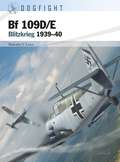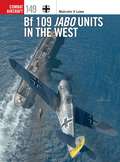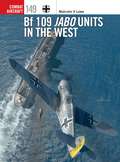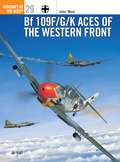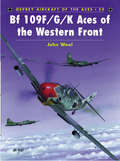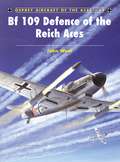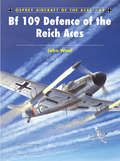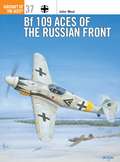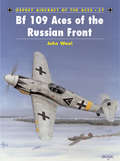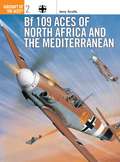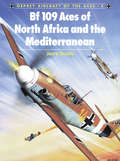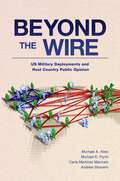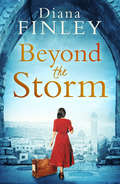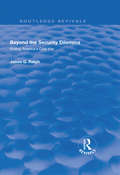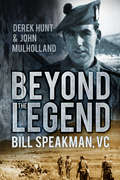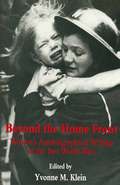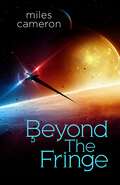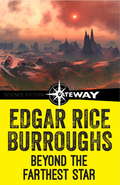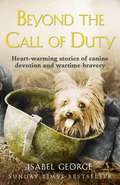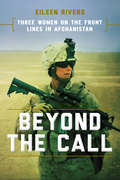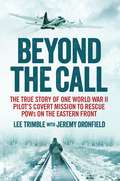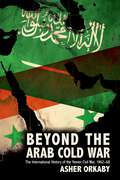- Table View
- List View
Bf 109D/E: Blitzkrieg 1939–40 (Dogfight)
by Malcolm V. LoweUsing first-hand accounts and brand-new artwork, this book brings to life the realities of flying the Bf 109 in combat during the very first battles of World War II.The Bf 109 was one of the principal fighter aircraft types in the Luftwaffe's inventory during the opening months of World War II and it was central to many of Germany's early victories, before coming up against the unbeatable RAF during the Battle of Britain.This book presents first-hand experiences of the pilots who flew the Bf 109E, the aircraft which first featured a Daimler-Benz DB 601 powerplant, and which was in the front line in the skies over Poland, the Low Countries and France, and the older Bf 109D, still in use in the Polish campaign.The early variants of the Messerschmitt fighter, the Bf 109E-1, Bf 109E-2 and Bf 109E-3, swept all before them during the opening wartime campaigns, their successes only fading at the Battle of France, when the Bf 109's seasoned pilots encountered modern and well-flown RAF and Armée de l'Air fighters.In a rigorous and engaging new analysis, Luftwaffe aviation expert Malcolm V. Lowe examines and assesses the Bf 109 as a fighting machine from the perspective of the Luftwaffe at the forefront of the German blitzkrieg. Contemporary photographs and specially commissioned artwork, including a dramatic battlescene, armament views, technical diagrams and ribbon diagrams illustrating step-by-step each battle tactic of the main dogfights explored in the book, bring the experiences of the Bf 109 pilots vividly to life.
Bf 109 Jabo Units in the West (Combat Aircraft)
by Malcolm V. LoweUsing specially commissioned artwork and detailing technical specifications, this book explores the Bf 109's different roles occasioned by wartime necessity, from its employment as a fighter to its evolution as a fighter-bomber.One of the principal types in the Luftwaffe's inventory at the beginning of World War II, the piston-engined Bf 109 was central to the many initial victories that the Germans achieved before coming up against the unbeatable RAF during the Battle of Britain. Nevertheless, by the second half of 1940 the Bf 109's operability was widened due to operational needs and it was flown as a fighter-bomber for precision attacks in Southern England. At first ad hoc conversions were made 'in the field' to allow the aircraft to carry a bomb or extra fuel tank. Such modifications were soon formalised by Messerschmitt, which created the Jabo Bf 109s. Drawing from pilots' first-hand accounts, author Malcolm V. Lowe explores the number of specialised units, including Lehrgeschwader 2 and dedicated fighter-bomber sections of standard fighter units such as 10. Staffel of Jagdgeschwader 26, which flew this highly specialised fighter-bomber. Including technical specifications, rare photographs and outstanding artwork, this book explores the Jabo versions of the Bf 109E, F and G both on the production line and with the addition of Rüstsätze field conversion kits.
Bf 109 Jabo Units in the West (Combat Aircraft #149)
by Malcolm V. LoweUsing specially commissioned artwork and detailing technical specifications, this book explores the Bf 109's different roles occasioned by wartime necessity, from its employment as a fighter to its evolution as a fighter-bomber.One of the principal types in the Luftwaffe's inventory at the beginning of World War II, the piston-engined Bf 109 was central to the many initial victories that the Germans achieved before coming up against the unbeatable RAF during the Battle of Britain. Nevertheless, by the second half of 1940 the Bf 109's operability was widened due to operational needs and it was flown as a fighter-bomber for precision attacks in Southern England. At first ad hoc conversions were made 'in the field' to allow the aircraft to carry a bomb or extra fuel tank. Such modifications were soon formalised by Messerschmitt, which created the Jabo Bf 109s. Drawing from pilots' first-hand accounts, author Malcolm V. Lowe explores the number of specialised units, including Lehrgeschwader 2 and dedicated fighter-bomber sections of standard fighter units such as 10. Staffel of Jagdgeschwader 26, which flew this highly specialised fighter-bomber. Including technical specifications, rare photographs and outstanding artwork, this book explores the Jabo versions of the Bf 109E, F and G both on the production line and with the addition of Rüstsätze field conversion kits.
Bf 109 F/G/K Aces of the Western Front (Aircraft of the Aces)
by John WealThe follow--on volume to Osprey Aircraft of the Aces 11 Bf 109D/E Aces 1939-41, this book charts the story of the myriad aces who flew the later marks of Messerschmitt fighter through to VE-Day. As good as the Emil had been during the opening 18 months of the war, the aircraft was being progressively bettered in virtually all aspects of aerial combat by the Spitfire come 1941, so Messerschmitt updated and improved the breed, firstly with the introduction of the Friedrich and then the multi-variant Gustav.
Bf 109 F/G/K Aces of the Western Front (Aircraft of the Aces #29)
by John WealThe follow--on volume to Osprey Aircraft of the Aces 11 Bf 109D/E Aces 1939-41, this book charts the story of the myriad aces who flew the later marks of Messerschmitt fighter through to VE-Day. As good as the Emil had been during the opening 18 months of the war, the aircraft was being progressively bettered in virtually all aspects of aerial combat by the Spitfire come 1941, so Messerschmitt updated and improved the breed, firstly with the introduction of the Friedrich and then the multi-variant Gustav.
Bf 109 Defence of the Reich Aces (Aircraft of the Aces)
by John WealThis volume tells the story of the daylight air battles over Germany through the eyes of the Bf 109 aces involved. It traces the development of the aerial defence of the Reich from its small beginnings to arguably the most savage and costliest campaign in the history of aerial warfare. The Luftwaffe pilots explain their tactics and relate their experiences – in the early days, waiting for short-ranged Allied fighters to turn back before attacking the bombers, the see-saw battle for aerial supremacy that followed, the advent of the P-51 and its devastating effect, the growing might of the heavy bomber streams and the final desperate measures against overwhelming odds. The story is predominantly that of the Bf 109's struggle to defeat the US Eighth Air Force, although latterly both the 'mediums' of the US Ninth Air Force and the 'heavies' of RAF Bomber Command were also active by day over Germany.
Bf 109 Defence of the Reich Aces (Aircraft of the Aces #68)
by John WealThis volume tells the story of the daylight air battles over Germany through the eyes of the Bf 109 aces involved. It traces the development of the aerial defence of the Reich from its small beginnings to arguably the most savage and costliest campaign in the history of aerial warfare. The Luftwaffe pilots explain their tactics and relate their experiences – in the early days, waiting for short-ranged Allied fighters to turn back before attacking the bombers, the see-saw battle for aerial supremacy that followed, the advent of the P-51 and its devastating effect, the growing might of the heavy bomber streams and the final desperate measures against overwhelming odds. The story is predominantly that of the Bf 109's struggle to defeat the US Eighth Air Force, although latterly both the 'mediums' of the US Ninth Air Force and the 'heavies' of RAF Bomber Command were also active by day over Germany.
Bf 109 Aces of the Russian Front (Aircraft of the Aces)
by John Weal Iain WyllieThe highest scoring aces of any aerial conflict were the Luftwaffe pilots involved in the bloody combats on the Russian Front. The most common fighter used by these pilots was the Bf 109, which was involved in the action from Operation Barbarossa in June 1941, through to the doomed Defence of the Reich in 1945. Units like JGs 5, 52 and 54 all flew the Messerschmitt fighter, progressing from Emil to Gustav variants. This volume includes all the high-scoring aces, and explains just how difficult a job the Jagdwaffe faced on the Russian Front, and how its experts achieved such overwhelming scores. Aircraft of the Aces 6 and 37 are also available in a single volume as 'German Aces of the Russian Front'.
Bf 109 Aces of the Russian Front (Aircraft of the Aces #37)
by John Weal Iain WyllieThe highest scoring aces of any aerial conflict were the Luftwaffe pilots involved in the bloody combats on the Russian Front. The most common fighter used by these pilots was the Bf 109, which was involved in the action from Operation Barbarossa in June 1941, through to the doomed Defence of the Reich in 1945. Units like JGs 5, 52 and 54 all flew the Messerschmitt fighter, progressing from Emil to Gustav variants. This volume includes all the high-scoring aces, and explains just how difficult a job the Jagdwaffe faced on the Russian Front, and how its experts achieved such overwhelming scores. Aircraft of the Aces 6 and 37 are also available in a single volume as 'German Aces of the Russian Front'.
Bf 109 Aces of North Africa and the Mediterranean (Aircraft of the Aces #2)
by Jerry Scutts Chris DaveyTotally outnumbered throughout their short two-year sojourn in the Western Desert, the crack fighter pilots of the handful of Jagdgeschwader in-theatre fought an effective campaign in support of Rommel's Afrika Korps against the British and American forces. Relying almost exclusively on the Luftwaffe's staple fighter of World War 2, the Messerschmitt Bf 109, the battle-hardened aces used the aircraft's superior performance to achieve incredible scores against the Allies. Similarly, once pushed out of North Africa, these units continued to take the fight to the RAF and USAAF from makeshift bases in northern Italy.
Bf 109 Aces of North Africa and the Mediterranean (Aircraft of the Aces #2)
by Jerry Scutts Chris DaveyTotally outnumbered throughout their short two-year sojourn in the Western Desert, the crack fighter pilots of the handful of Jagdgeschwader in-theatre fought an effective campaign in support of Rommel's Afrika Korps against the British and American forces. Relying almost exclusively on the Luftwaffe's staple fighter of World War 2, the Messerschmitt Bf 109, the battle-hardened aces used the aircraft's superior performance to achieve incredible scores against the Allies. Similarly, once pushed out of North Africa, these units continued to take the fight to the RAF and USAAF from makeshift bases in northern Italy.
Beyond the Wire: US Military Deployments and Host Country Public Opinion (BRIDGING THE GAP SERIES)
by Michael A. Allen Carla Martinez Machain Michael E. Flynn Andrew StraversIn a time where US deployments are uncertain, this book shows how US service members can either build the necessary support to sustain their presence or create added animosity towards the military presence. The United States stands at a crossroads in international security. The backbone of its international position for the last 70 years has been the massive network of overseas military deployments. However, the US now faces pressures to limit its overseas presence and spending. In Beyond the Wire, Michael Allen, Michael Flynn, Carla Martinez Machain, and Andrew Stravers argue that the US has entered into a "Domain of Competitive Consent" where the longevity of overseas deployments relies upon the buy-in from host-state populations and what other major powers offer in security guarantees. Drawing from three years of surveys and interviews across fourteen countries, they demonstrate that a key component of building support for the US mission is the service members themselves as they interact with local community members. Highlighting both the positive contact and economic benefits that flow from military deployments and the negative interactions like crime and anti-base protests, this book shows in the most rigorous and concrete way possible how US policy on the ground shapes its ability to advance its foreign policy goals.
Beyond the Wire: US Military Deployments and Host Country Public Opinion (BRIDGING THE GAP SERIES)
by Carla Martinez Machain Michael A. Allen Michael E. Flynn Andrew StraversIn a time where US deployments are uncertain, this book shows how US service members can either build the necessary support to sustain their presence or create added animosity towards the military presence. The United States stands at a crossroads in international security. The backbone of its international position for the last 70 years has been the massive network of overseas military deployments. However, the US now faces pressures to limit its overseas presence and spending. In Beyond the Wire, Michael Allen, Michael Flynn, Carla Martinez Machain, and Andrew Stravers argue that the US has entered into a "Domain of Competitive Consent" where the longevity of overseas deployments relies upon the buy-in from host-state populations and what other major powers offer in security guarantees. Drawing from three years of surveys and interviews across fourteen countries, they demonstrate that a key component of building support for the US mission is the service members themselves as they interact with local community members. Highlighting both the positive contact and economic benefits that flow from military deployments and the negative interactions like crime and anti-base protests, this book shows in the most rigorous and concrete way possible how US policy on the ground shapes its ability to advance its foreign policy goals.
Beyond the Storm
by Diana Finley‘Phenomenal… Beautifully written and emotionally charged. I cried… Outstanding.’ NetGalley reviewer, 5 stars An epic tale of love, war, and the secrets we keep…
Beyond the Security Dilemma: Ending America's Cold War (Routledge Revivals)
by Jason G. RalphThis title was first published in 2001. The security dilemma has long been at the heart of the security studies discipline. Moving beyond this, this book attacks the assumptions of the traditional concept and redefines the security dilemma in a way more useful for examining security policy. By exposing the historical and social contingency of the traditional concept, the book argues that the security dilemma is an important though not a permanently operating feature of international politics. An examination of US policy towards the Soviet Union demonstrates the limits of perceiving the Cold War and challenges the role that American security policy has played in the process of constructing a transatlantic security community.
Beyond the Security Dilemma: Ending America's Cold War (Routledge Revivals)
by Jason G. RalphThis title was first published in 2001. The security dilemma has long been at the heart of the security studies discipline. Moving beyond this, this book attacks the assumptions of the traditional concept and redefines the security dilemma in a way more useful for examining security policy. By exposing the historical and social contingency of the traditional concept, the book argues that the security dilemma is an important though not a permanently operating feature of international politics. An examination of US policy towards the Soviet Union demonstrates the limits of perceiving the Cold War and challenges the role that American security policy has played in the process of constructing a transatlantic security community.
Beyond the Legend: Bill Speakman VC
by Derek Hunt John MulhollandBeyond the Legend is the authorised biography of William (Bill) Speakman,who was awarded one of only four Victoria Crosses for action in the Korean War. It covers his sometimes controversial life, from his childhood in Altrincham, Cheshire, to his later life in South Africa – about which little has been known previously. Authors Derek Hunt and John Mulholland also explore the myth of the ‘beer bottle VC’ (in which Speakman was said to have fended off the Chinese Communist Army by throwing empty beer bottles at them after they ran out of grenades), bringing to light what really happened on United Hill in November 1951. Speakman held the attacking Chinese army at bay for over four hours and led a final charge that allowed his company to withdraw from the hill. After Korea, he saw active service in Malaya, Borneo and Aden before retiring from the army, with the rank of sergeant, in 1968. Bill Speakman is one of only two surviving VC holders of the British Army and a true British hero.
Beyond the Home Front: Women's Autobiographical Writing of the Two World Wars
by Yvonne M. KleinHow women perceived the world wars of this century is markedly different from the common perception of how these wars affected their lives. Drawing on a broad variety of sources, many long out of print, this anthology brings together the autobiographical accounts of both famous and ordinary women to provide a new view of the changing role of women as they experienced the sorrows, the terrors and the occasional joys of war in the twentieth century.
Beyond the Fringe: An Arcana Imperii Collection
by Miles CameronReturn to the Universe of the ARCANA IMPERII with a collection of novellas from Miles Cameron.Following the events of ARTIFACT SPACE, the galaxy continues to change and expand. Frontiers are challenged and what was once a safe space becomes contested, hostile, and unpredictable.From normal people caught up in the unstoppable machinations of politics and war, to spies faced with making the ultimate sacrifice for their nations, these stories follow the DHC as it faces a challenge to everything it holds dear - human rights, fairness and equality. When a rogue system questions their values and power, how can they stay true to their beliefs and protect their citizens?And what are these rumours about new aliens lurking beyond the edges of known space?Praise for Artifact Space:'Thrilling, terrifying and sublime' - The Times'A superb military science fiction adventure, in a fascinating universe' - Garth Nix'An extraordinary piece of science fiction' - FanFi Addict'A tense, human, sci-fi story about a woman carving out a life for herself in a world she was told she'd never belong in' - The Fantasy Inn'Artifact Space blew my mind' - The Quaint Book Nook'This book sparked joy' - Locus
Beyond the Farthest Star: Large Print
by Edgar Rice BurroughsOn Poloda, a world far beyond the reach of any telescope on Earth, there appeared a mysterious being. The inhabitants called him Tangor - 'from nothing' - and enlisted him in their savage warfare. And Tangor, the Earthman so strangely transported to a remote planet, took part in one thrilling adventure after another in the battles which were so like, yet unlike, those of his own twentieth century.
Beyond the Call of Duty: Heart-warming Stories Of Canine Devotion And Bravery
by Isabel GeorgeA second collection of incredible and heart-warming canine stories from around the world, from the bestselling author of The Dog That Saved My Life.
Beyond the Call: Three Women on the Front Lines in Afghanistan
by Eileen RiversA riveting account of three women who fought shoulder-to-shoulder with men and worked with local women to restore their lives and push back the Taliban They marched under the heat with 40-pound rucksacks on their backs. They fired weapons out of the windows of military vehicles, defending their units in deadly battles. And they did things that their male counterparts could never do--gather intelligence on the Taliban from the women of Afghanistan. As females they could circumvent Muslim traditions and cultivate relationships with Afghan women who were bound by tradition not to speak with American military men. And their work in local villages helped empower Afghan women, providing them with the education and financial tools necessary to rebuild their nation--and the courage to push back against the insurgency that wanted to destroy it. For the women warriors of the military's Female Engagement Teams (FET) it was dangerous, courageous, and sometimes heartbreaking work.Beyond the Call follows the groundbreaking journeys of three women as they first fight military brass and culture and then enemy fire and tradition. And like the men with whom they served, their battles were not over when they returned home.
Beyond the Call: The True Story of One World War II Pilot's Covert Mission to Rescue POWs on the Eastern Front
by Lee Trimble Jeremy DronfieldAs the Red Army advanced across Poland in 1945, thousands of freed Allied POWs – viewed by the Soviets as cowards or potential spies – were abandoned to wander the war-torn Eastern Front. In total secrecy, the OSS – wartime forerunner to the CIA – conceived an undercover mission to rescue them. The man they picked to undertake it was veteran Eighth Air Force bomber pilot Captain Robert Trimble. With little covert training, Trimble survived by wit, courage, and a determination to do some good in a terrible war. Alone, he faced up to the terrifying Soviet secret police and saved hundreds of lives, fighting his own battle against the trauma of war while finding his way home to his wife and child. Based on hours of testimony from his father, Beyond the Call is written by Trimble’s son and by British historian Jeremy Dronfield. It is a filmic, inspiring story of a hitherto unknown true hero.
Beyond the Arab Cold War: The International History of the Yemen Civil War, 1962-68 (Oxford Studies in International History)
by Asher OrkabyBeyond the Arab Cold War brings the Yemen Civil War, 1962-68, to the forefront of modern Middle East History. During the 1960s, in the wake of a coup against Imam Muhammad al-Badr and the formation of the Yemen Arab Republic (YAR), Yemen was transformed into an arena of global conflict. Believing al-Badr to be dead, Egypt, the Soviet Union, and most countries recognized the YAR. But when al-Badr unexpectedly turned up alive, Saudi Arabia and Britain offered support to the deposed Imam, drawing Yemen into an internationally-sponsored civil war. Throughout six years of major conflict, Yemen sat at the crossroads of regional and international conflict as dozens of countries, international organizations, and individuals intervened in the local South Arabian civil war. Yemen was a showcase for a new era of UN and Red Cross peacekeeping, clandestine activity, Egyptian counterinsurgency, and one of the first largescale uses of poison gas since WWI. Events in Yemen were not dominated by a single power, nor were they sole products of US-Soviet or Saudi-Egyptian Arab Cold War rivalry. Britain, Canada, Israel, the UN, the US, and the USSR joined Egypt and Saudi Arabia in assuming varying roles in fighting, mediating, and supplying the belligerent forces. Despite Cold War tensions, Americans and Soviets appeared on the same side of the Yemeni conflict and acted mutually to confine Egyptian President Gamal Abdel Nasser to the borders of South Arabia. The end of the Yemen Civil War marked the end of both Nasser's Arab Nationalist colonial expansion and the British Empire in the Middle East, two of the most dominant regional forces. This internationalized conflict was a pivotal event in Middle East history, overseeing the formation of a modern Yemeni state, the fall of Egyptian and British regional influence, another Arab-Israeli war, Saudi dominance of the Arabian Peninsula, and shifting power alliances in the Middle East that continue to lie at the core of modern-day conflicts in South Arabia.
Beyond the Arab Cold War: The International History of the Yemen Civil War, 1962-68 (Oxford Studies in International History)
by Asher OrkabyBeyond the Arab Cold War brings the Yemen Civil War, 1962-68, to the forefront of modern Middle East History. During the 1960s, in the wake of a coup against Imam Muhammad al-Badr and the formation of the Yemen Arab Republic (YAR), Yemen was transformed into an arena of global conflict. Believing al-Badr to be dead, Egypt, the Soviet Union, and most countries recognized the YAR. But when al-Badr unexpectedly turned up alive, Saudi Arabia and Britain offered support to the deposed Imam, drawing Yemen into an internationally-sponsored civil war. Throughout six years of major conflict, Yemen sat at the crossroads of regional and international conflict as dozens of countries, international organizations, and individuals intervened in the local South Arabian civil war. Yemen was a showcase for a new era of UN and Red Cross peacekeeping, clandestine activity, Egyptian counterinsurgency, and one of the first largescale uses of poison gas since WWI. Events in Yemen were not dominated by a single power, nor were they sole products of US-Soviet or Saudi-Egyptian Arab Cold War rivalry. Britain, Canada, Israel, the UN, the US, and the USSR joined Egypt and Saudi Arabia in assuming varying roles in fighting, mediating, and supplying the belligerent forces. Despite Cold War tensions, Americans and Soviets appeared on the same side of the Yemeni conflict and acted mutually to confine Egyptian President Gamal Abdel Nasser to the borders of South Arabia. The end of the Yemen Civil War marked the end of both Nasser's Arab Nationalist colonial expansion and the British Empire in the Middle East, two of the most dominant regional forces. This internationalized conflict was a pivotal event in Middle East history, overseeing the formation of a modern Yemeni state, the fall of Egyptian and British regional influence, another Arab-Israeli war, Saudi dominance of the Arabian Peninsula, and shifting power alliances in the Middle East that continue to lie at the core of modern-day conflicts in South Arabia.
